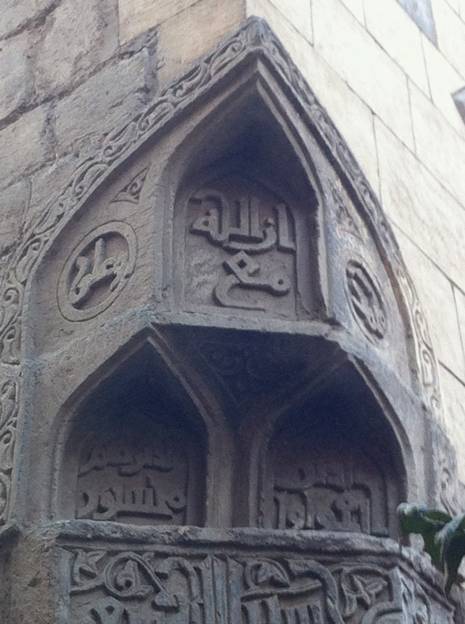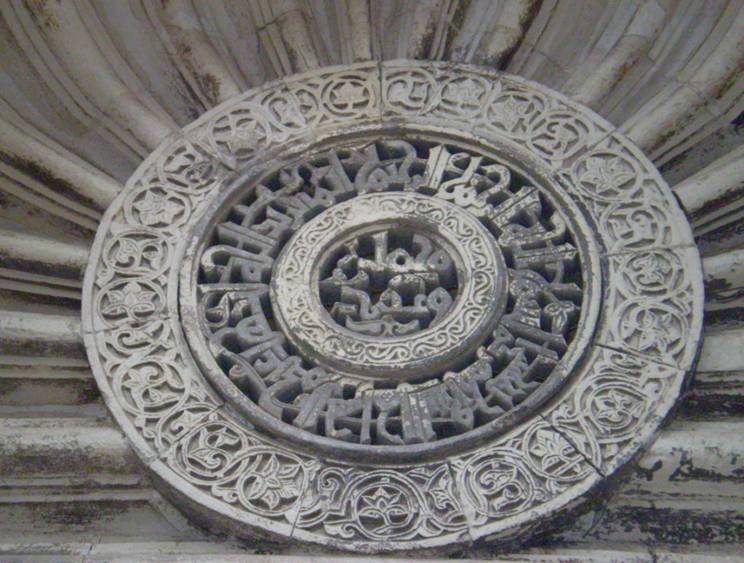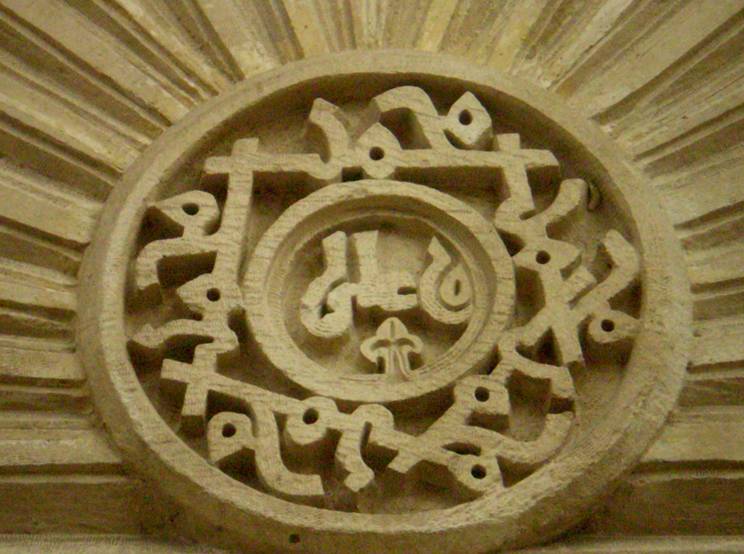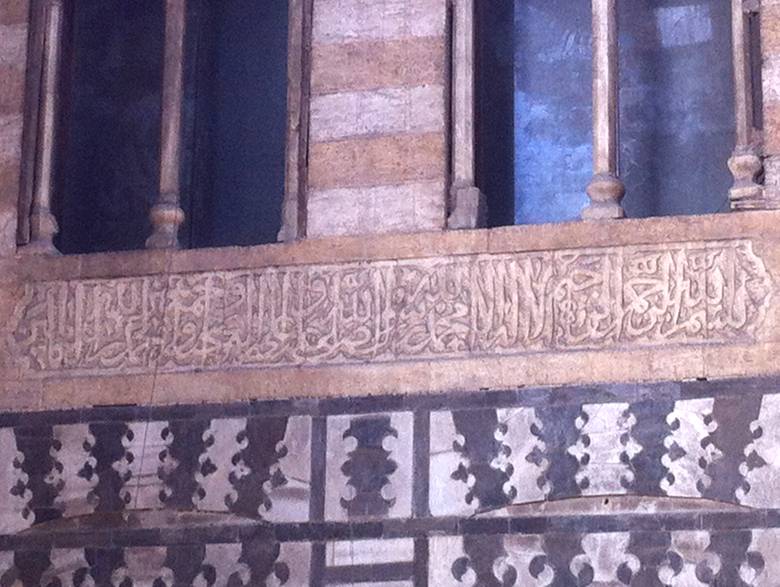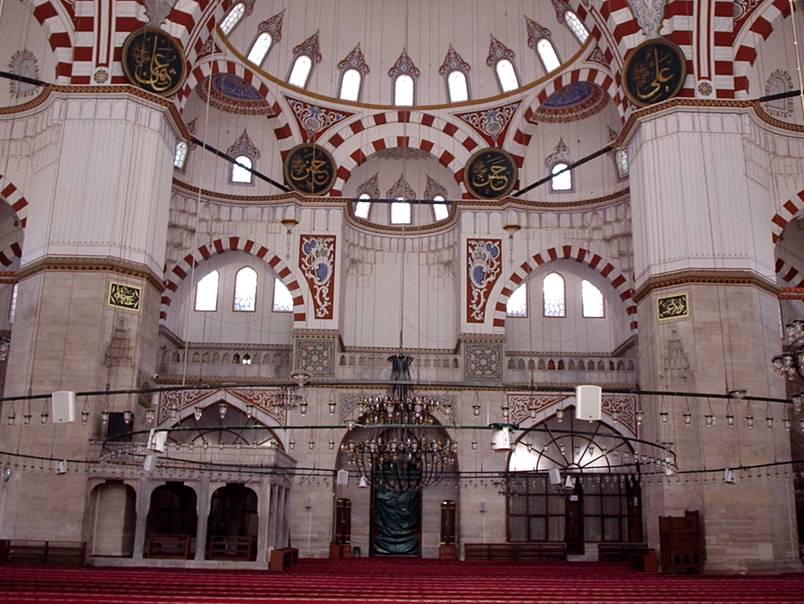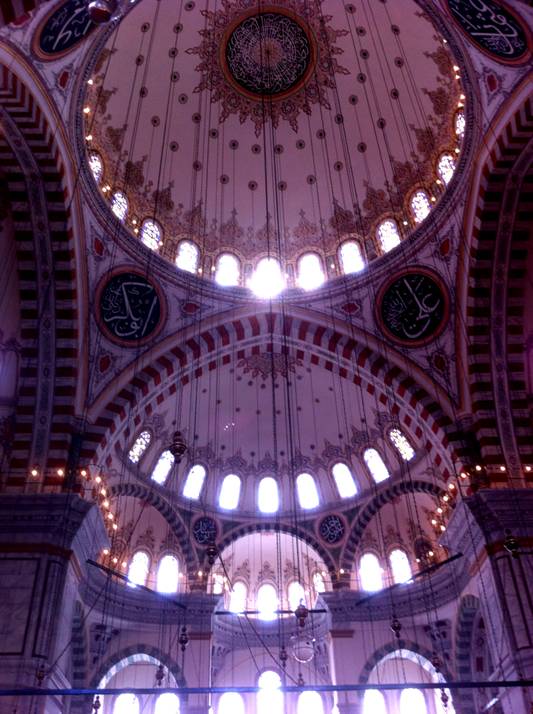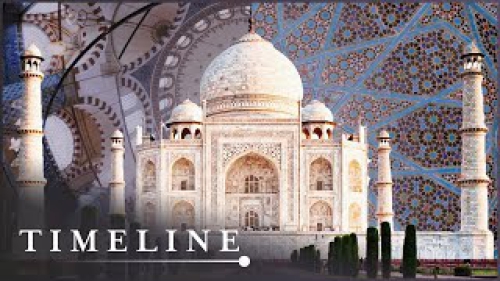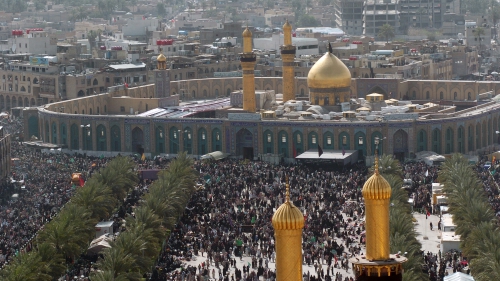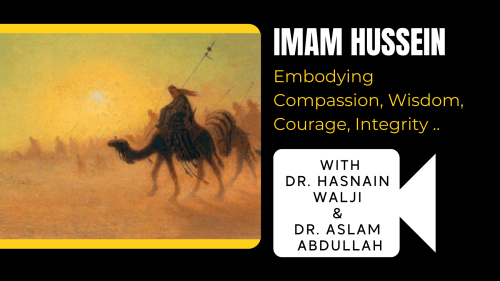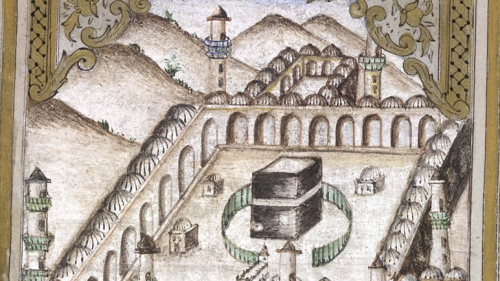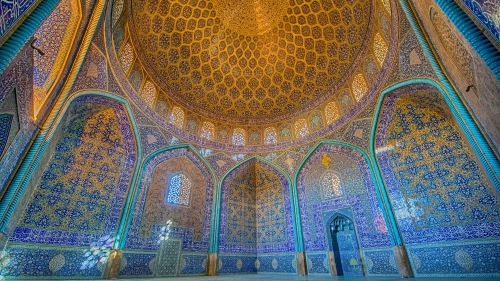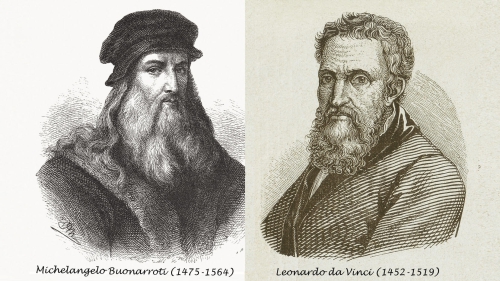The Impact of Early Sunni-Shi'ah Conflicts on Art and Architecture

 |
| Elaborately decorated front facade of the al-Aqmar Mosque. |
The Fatimids were a major Shi'ah Isma'ili dynasty. Established in 297 AH /909 CE in Ifriqiyah (today's Tunisia, Western Libya and Eastern Algeria), the seat of the Fatimids was later transferred to Egypt in 362 AH /972 CE, and the dynasty was finally toppled by Salahuddin al-Ayyubi (Saladin) (d. 590 AH /1193 CE) in 567 AH /1171 CE.
| The Mosque of al-Azhar first built by the Fatimids | A corner of the Mosque of al-Aqmar |
The Fatimids were among the first in Islamic civilization who used the power of writing signs and symbols on buildings in order to advance and publicize their ideological struggle. The relatively small mosque of al-Aqmar (the Moonlit, or Gray mosque) in Cairo founded by Ma'mun al-Bata'ihi (d. 519 AH /1125 CE), vizier of the caliph-Imam al-Amir Biahkamillah (d. 525 AH /1130 CE) in 519 AH /1125 CE, is an ideal extant illustration of this Fatimid tradition. A striking feature of the building is the decoration of its projecting portal and the entire front façade which faces the major al-Mu'izz Li-Dinillah street which, in turn, forms the main axis of the city of Cairo stretching from Bab (Gate) al-Zuwayla in the south to Bab (Gate) al-Futuh in the north, and virtually dividing the city into two corresponding parts. The hood of each niche on the mosque's façade is composed of radiating flutes with a central medallion.
The following Qur'anic words are inscribed in a concentric circle medallion over the imposing entrance portal: "... Allah intends only to remove from you the impurity (of sin), O people of the (Prophet's) household, and to purify you with (extensive) purification." (Al-Ahzab, 9:33). In the centre of that medallion are the names of Muhammad and 'Ali. Inside another two smaller medallions at right and left wings there is the name of 'Ali encircled with the name of Muhammad written 5 times. Moreover, at each of the mosque's two corners which flank the mosque's front wall, there are three small niches, one above the other two, wherein the following Qur'anic words: "Indeed, Allah is with (the top niche) those who fear Him (the bottom right niche) and those who are doers of good (the bottom left niche)." (Al-Nahl, 16:128), are engraved. On both sides of the top niche there are discs the right one having the name of Muhammad and the left one of 'Ali. Hence, the top portion can be also read as: "Indeed, Allah is with Muhammad and 'Ali".
| This is one of 25 identical stucco window grills in the al-Aqmar Mosque. The right small circle contains the name "Muhammad" and the left one "'Ali" | The following Qur'anic words are inscribed in a circle medallion over the imposing portal of al-Aqmar Mosque: "... Allah intends only to remove from you the impurity (of sin), O people of the (Prophet's) household, and to purify you with (extensive) purification." (al-Ahzab, 33). In the centre of that medallion are the names "Muhammad" and "'Ali". |
In the whole of the mosque, in addition, there are 25 elaborately decorated stucco window grills with the names of Muhammad and 'Ali etched inside two small discs placed almost in the middle on the right and left of each grill. Inside the right disk is the name of Muhammad and in the left one the name of 'Ali. Of those 25 intricately embellished stucco window grills, 23 face the interior of the mosque and two the exterior. The latter is part of the rich decorative style and language of the mosque's front facade. And finally, above the praying niche or mihrab of the mosque, tributes for the Fatimid (Isma'ili) Imams and caliphs are evidenced.That said, ornamental deep and shallow niches, as well as flat arches, with their hoods composed of radiating flutes with or without circle medallions being placed either in the center or independently next to those niches and arches -- irrespective of whether there are inscriptions or not in the midpoints of those medallions - denote, perhaps, the most recognizable features of the Fatimid art and architecture.
To Irene A. Bierman, circle disk medallions are "immediately recognizable by Isma'ilis as the sign of Isma'ilism." What is more, the hood composed of radiating flutes, or the ribbed shell hood, with its pierced medallion in the mosque of al-Aqmar was the prototype of all the later cusped, ribbed, blind, keel-arch decoration which remains somewhat vogue in Cairo's buildings. As a matter of fact, both fluted niche hoods and a brand of medallions as simple and inelaborate decorative media existed in Egypt even before the Fatimids, as evidenced by the way the mosque of Ahmad b. Tulun (d. 271 AH / 884 CE) had been decorated. However, the Fatimids perfected those media and made sure that ever after they remained integral to the vocabulary of diverse Islamic art and architecture in Egypt and beyond.
| Another medallion in the center of the hood of a side niche ornamenting the front facade of al-Aqmar Mosque. | The hood of another side niche on the façade of al-Aqmar Mosque which is composed of radiating flutes with a central medallion. Just like the previous medallion, this medallion, too, contains the name "'Ali" encircled with the name "Muhammad" written 5 times. |
Without a doubt, elaborately decorating the front facade of the al-Aqmar mosque with intriguing inscriptions suggestive of Shi'ism, plus setting the façade at a different angle from the rest of the mosque to ensure that it faced onto, and was parallel with, the main al-Mu'izz Li-Dinillah street, radiated certain messages to both Shi'is and Sunnis. To the former, it was a message of intrinsic unanimity, espousal, endorsement and even craved-for revival, bearing in mind that at the time of the mosque's construction, the Fatimid power was rapidly on the wane and was marred by the loss of some important territories to the Crusaders, as well as by the escalating internal schism. The founder of the mosque, the vizier Ma'mun al-Bata'ihi, therefore, was known as the restorer of "Shi'i orthodoxy".
To Sunnis, on the other hand, the front façade of the mosque and the way it was positioned and adorned was an oblique and, at the same time, unaggressive message that insinuated Sunni religious inferiority, inadequacy, and an urge for soul searching as to who exactly was right and who was wrong. Hence, unlike the fanatical initiatives of al-Hakim, which caused widespread resentment and hostilities, and so, their speedy rescinding, the more amiable ones, such as the ornamental styles and themes of the mosque of al-Aqmar, remained undisturbed and operative. Aside from being planned to face and be parallel to the main city's street and its artery, so as to convey the intended messages to the meant audiences, it likewise was not by chance that the al-Aqmar mosque for the same socio-political and spiritual purposes was located near the site which was occupied by two great Fatimid palaces. As a result, the whole area, and the part of the al-Mu'izz Li-Dinillah street, which adjoined the palaces and stood in the vicinity of the mosque, were always bustling with life. There rarely ever were anywhere in the city more people, shops, institutions and generally life activities than in the said areas. This applied not only to the Fatimid era, but also to the subsequent Ayyubid and Mamluki eras, as hinted by Ibn Battuta (d. 779 AH /1377 CE) who visited the city of Cairo in 727 AH / 1326 CE.
Moreover, in the mosque of al-Hakim, there is a huge medallion with the names of Muhammad and 'Ali etched in its center. The medallion serves as an ornament and is positioned just above the mosque's praying niche (mihrab). Bearing in mind the time difference between the mosque of al-Hakim and the al-Aqmar mosque, and between the reigns and years of the people responsible for their construction, it seems as though the medallion functioned as a precursor for what later emerged with slight design and content variations as a distinct Fatimid trend.On the same note, inside the mausoleum of Sayyidah Ruqayyah, a daughter of 'Ali b. Abi Talib whose mother, however, was not Fatimah but another wife of 'Ali, in the center of the hood of a praying niche there is a medallion in the center of which the name of 'Ali is carved. The name is framed with the name of Muhammad etched in an interlocking fashion six times.
| The Mosque of al-Hakim | A huge medallion above the mihrab of the Mosque of al-Hakim. In the centre of the medallion are the names of Muhammad and 'Ali |
What's more, just above the niche, the following Qur'anic words with reference to the Prophet's household are inscribed: "Allah intends only to remove from you the impurity (of sin), O people of the (Prophet's) household." (Al-Ahzab, 33:33) The mausoleum was built by the Fatimids in 528 AH / 1133 CE. That was a facet of their conspicuous culture of architecturally glorifying some of the deceased members of ahl al-bayt, genuinely or otherwise. Parenthetically, it was the Shi'ah at large who contributed one of the greater shares to the evolution of funerary architecture, or the architecture of dead, within the fold of Islamic culture and civilization.
As soon as they arrived in Egypt, it seems that the Fatimids went on an offensive with regard to using and manipulating the great potential of signs, symbols and canon writing. Thus, just above the Fatimid Cairo's Bab (Gate) al-Nasr on a panel, and on the city's wall adjoining the Bab (Gate) al-Futuh in a band, there are identical inscriptions which read as follows: "In the Name of Allah, the most Compassionate, the most Merciful; there is no god but Allah, the only One without a partner; Muhammad is Allah's messenger; 'Ali is Allah's wali (friend and one vested with the authority of God)." We have already mentioned that the Cairo walls and its gates were of the early structures erected in Egypt by Jawhar al-Siqili (d. 382 AH /992 CE), the conqueror of the place and the builder of Cairo. Both inscriptions faced the outside of the city. That means that every visitor to it was first and foremost welcomed by, and reminded of, their meanings, significance and role in shaping the Fatimid society, mind and culture.
Correspondingly, the mosque of Ahmad b. Tulun, which had been built exactly 94 years before the arrival of the Fatimids in Egypt, has a stucco panel with an elaborate arabesque whose highlight are the words: "There is no god but Allah; Muhammad is Allah's messenger; 'Ali is Allah's wali or friend". But to an insightful observer, such decorative panel is an alien addition to the mosque and its extremely modest and straightforward decorative style, especially in terms of the panel's placement, content and design. The panel rather looks like an adopted and directly transported element from the subsequent decoration and embellishment realms of the mosques of al-Hakim, al-Azhar, al-Aqmar and indeed of all the other Fatimid buildings, in particular those of the later periods. At any rate, it is believed that the decorative panel was part of what is today called "the Fatimid mihrab or praying niche" inside the mosque of Ahmad b. Tulun. The Fatimid mihrab was one of a few mihrabs that existed inside the mosque. This additionally boosts an argument that the mosque of Ahmad b. Tulun had somewhat a special place in the Fatimid psyche, as a result of which much of the form of its colossal and massive colonnades and the spacious courtyard served as a source of inspiration for the same inside the mosque of al-Hakim.
 |
 |
| An inscription above the Bab (Gate) al-Nasr in Cairo. | An inscription in the Mosque of Ahmad b. Tulun in Cairo. |
Reviling and insulting a number of leading companions of the Prophet (pbuh) was a well known Shi'ah-Isma'ili norm. After the establishment of the Shi'ah-Isma'ili Fatimid state, the matter was taken to a whole new level. Insulting and abusing the companions was done more commonly, more systematically and more freely. The most responsible caliph-Imam for the misdemeanor, certainly, was al-Hakim (d. 412 AH / 1021 CE). Apart from the conventional practices and means, he in the year 395 AH / 1004 CE ordered that near the entrances to the mosques and in the streets, insults and abuses against Abu Bakr, 'Umar, 'Uthman, 'A'ishah, Talhah, Zubayr, Mu'awiyah and 'Amr b. al-'As, be written. He also asked his state administrators outside Cairo to follow suit. However, two years later he rescinded his malicious initiative, although the practice of disparaging the companions continued unabated till the end of the Fatimid tenure. Al-Maqrizi (d. 845 AH /1441 CE) furnishes us with far more details about those actions of al-Hakim. He said that both the interior and exterior of the mosques, with no section thereof left, were covered with insulting and cursing phrases. The doorways of shops, houses, tombs and bazaars were also used for the same purpose. The insulting and cursing slogans were either written or engraved, using color and sometimes even gold.
As a small digression - to end with -- even the Shi'ah Buyids in the Muslim East, especially in Baghdad - who were firstly Zaydiyyah then Ithna Ashariyyah or Twelvers -- adopted moderately a similar approach in their own ideological confrontations with Sunnis. On the mosques, as well as on some erected posts and signboards, the standard words "Muhammad and 'Ali are the best of people; he who is content (with that) is grateful, and he who rejects (that), is an infidel" were regularly inscribed, now and again even with gold. But this campaign's intensity and scale were rather restricted and one-dimensional, so to speak. They were no match for those which the sophisticated Fatimid ideological promotional drive and machinery epitomized and set in motion.
A Sunni Response
So, therefore, during the lengthy and somewhat ideologically antagonistic Fatimid rule, Sunni-Shi'ah conflicts were intensified more than ever before. Throughout the same epoch, furthermore, modeling Shi'ism in general, and Isma'ilism in particular, as a conglomerate ideology and a comprehensive system of thought was perfected. This, in turn, called for the total crystallization of the concept of ahl al-sunnah wa al-jama'ah and the establishment of its exact implications, contents and parameters in the midst of the rife and epidemic sectarianism with numerous protagonists involved. Bringing into the mix the nuisance of Mu'tazilah, obviously, the matter was becoming much like a tit-for-tat tactic, making many impending moves and designs rather predictable. It goes without saying, therefore, that the fall of the Fatimids - as well as the fall of the Buyids - came as a great relief to many Muslims. In their wake, efforts were doubled for the all-embracing explication, propagation and implementation of Sunnism whenever and wherever such was considered necessary and possible. The wounds caused by the Buyids and Fatimids needed a long time to heal, and so, no sooner had they gone than certain measures were taken lest similar tribulations should recur, at least not in a foreseeable future and with the same intensity and scope. Restoring Sunnism, both conceptually and functionally, topped the agenda of everyone concerned.
Thus, for example, it is said about the Ayyubids, who deposed and succeeded the Fatimids, that they embarked on vigorously strengthening Sunni Muslim dominance in the region by introducing into Egypt, Syria and Jerusalem the concept of madrasah. Madrasahs were constructed in all Ayyubid major cities. They functioned primarily as academies of religious sciences aiming to teach and promote Sunnism and to try to convert Shi'is and Christians to Sunni Islam. The Ayyubids built scores of madrasahs in support of all four Sunni madhhabs, namely the Shafi'i, Hanafi, Maliki and Hanbali madhhabs. In the mid-7th AH / 13th CE century, which signified the final phase of the Ayyubid reign, some estimates suggest that in Damascus alone there were 40 Shafi'i, 34 Hanafi, 10 Hanbali, and three Maliki madrasahs. Comparable, or slightly lower, figures, it stands to reason, existed in Cairo, Alexandria, Aleppo and Jerusalem as well. When the traveler Ibn Jubayr (d. 614 AH /1217 CE) was in Damascus in 580 AH / 1184 CE, which was the early phase of the Ayyubid dynasty under Salahuddin al-Ayyubi (Saladin), he commented that there were 20 madrasahs in the city and they all symbolized the pride of (Sunni) Islam. Such was the intellectual climate under the Ayyubids that their rulers' wives, sons and daughters, commanders and nobles established and financed numerous educational institutions as well. What was really unusual of the time -- some accounts reveal -- even some common people followed suit. In Egypt alone, about 18 madrasahs, including two medical institutions, were established by commoners.
What is more, there were Ayyubid madrasahs wherein teaching was jointly conducted according to all four recognized madhhabs. Such madrasahs, surely, stood out as the most authentic Sunni establishments where mutual collaboration, acceptance and tolerance among the major Sunni sections and systems of thought were both preached and practiced. One of such madrasahs in Cairo was the Madrasah al-Salihiyyah which was founded by Sultan al-Malik al-Salih Najm al-Din Ayyub (d. 647 AH /1249 CE) in 641 AH / 1243 CE. Al-Maqrizi, while dwelling on this madrasah, observed that that was the first time in the history of Egypt that teaching was performed according to all four madhhabs at one place. Truly, the age of the Ayyubids was the age of Sunni learning and its numerous institutions. Educational institutions were regarded as prestigious institutions in society. In the words of Abdul Ali, "an idea of their importance may be derived from the fact that it was not possible to get a job in the government for anyone who did not receive his education in a madrasah."
|
|
| Apart from the names of the four rightly-guided caliphs, the names of a few prominent companions of the Prophet (pbuh) were also employed for decoration of Sultan al-Fatih Mosque in Istanbul, Turkey. |
On the same note, Sunnis were increasingly resorting to idolizing their spiritual and intellectual leaders and heroes, and to architecturally glorify them. A culture of inventing and venerating "Sunni saints" was steadily creeping in. As an illustration, the grave of Shafi'i (d. 204 AH/ 820 CE), at once the symbol and tower of strength of Islamic orthodoxy, became extremely popular for Sunnis in Egypt. Shafi'i's saintly personality and remarkable spiritual and scholarly legacy were revered, by some even venerated, not only in Egypt, but also beyond throughout the Muslim world. This practice was further popularized by the fact that Salahuddin al-Ayyubi (Saladin), the victor over the Fatimids, founded a madrasah dedicated to the Shafi'i madhhab of the Islamic law near Shafi'i's grave. Later, a mausoleum with a wooden dome over Shafi'i's grave was erected in 608 AH /1211 CE by the fourth Ayyubid ruler al-Malik al-Kamil (d. 636 AH /1238 CE), whose grave, along with his mother's, is also under this dome and a few steps away from Shafi'i's grave. This "is the first officially sponsored mausoleum to be built for a Sunni theologian after the extinguishing of the Isma'ili Fatimids in 567 AH /1171 CE. It is also the largest detached mausoleum in Egypt. Paradoxically, the Fatimid practice of building domed mausoleums for 'Alid (Shi'i) saints as a means of promoting their Shi'i agenda and gathering popular support for the Fatimid Imams was adopted by the same leaders who eradicated all signs of Shi'ism in Egypt. In fact, this mausoleum is regarded as the symbol of the triumph of orthodoxy over heterodoxy." Similarly, a mausoleum and madrasah in the name of Abu Hanifah (d. 150 AH /767 CE), another symbol and pillar of strength of Islamic orthodoxy, were erected in Baghdad in 459 AH /1066 CE, approximately 11 years after the Sunni Saljuqs had retaken the 'Abbasid capital from the Buyids.
Surely, it was not by chance that during the Fatimid period, as well as that of the Buyids, some major works on elucidating, defending and rationalizing Sunnism and its creedal, jurisprudential and ethical beliefs and practices were composed. Abu Ja'far al-Tahawi (d. 321 AH/ 933 CE), who was among the first to officially in academic circles use the idiom ahl al-sunnah wa al-jama'ah, died around 24 years after the establishment of the Fatimids in Ifriqiyah, and two years before the emergence of the Buyids. The science of heresiography was basically born during the same period in question. Some of the most celebrated heresiographers, such as Shahrastani (d. 548 AH/ 1153 CE) and Abu Mansur al-Baghdadi (d. 429 AH/ 1037 CE), lived then. In the same vein, the most eminent speculative theologians, such as Abu al-Hasan al-Ash'ari (d. 325 AH/ 936 CE), Abu Mansur al-Maturidi (d. 333 AH /944 CE), Abu Bakr al-Baqilani (d. 404 AH /1013 CE) and Abu Hamid al-Ghazali (d. 505 AH /1111 CE) also lived during the same critical era. It was thus natural for Abu Hamid al-Ghazali to compose a book against Isma'ilis and the Isma'ili doctrines entitled Fada'ih al-Batiniyyah (Ignominies of the Esoterics). The name of al-Mawardi (d. 450 AH /1058 CE), a jurist of the Shafi'i madhhab, could be mentioned here as well. His significance lies in the fact that he contributed a vital share in philosophically and jurisprudentially reasserting and shoring up the authority of the 'Abbasid caliphs, and with it the legitimacy and authority of the caliphate as an institution, in the face of the unrelenting Shi'i menace. Al-Mawardi wrote a famous book called al-Ahkam al-Sultaniyyah (the Ordinances of Government). In it, an influential statement of Muslim (Sunni) political theory was made. Details were also furnished concerning the significance and functions of the caliphate government, which under the Buyids were rendered vague and indefinite. Lastly, that the sixth and final Sunni canonical hadith collection was completed just around the appearance of the Fatimids as a religious and political force ought to be mentioned, too, although such a feat took place in distant Khorosan. The last of the six hadith collectors was al-Nasa'i, who died in 303 AH /915 CE, six years after the Fatimids had established themselves as the overambitious rulers of Ifriqiyyah in 297 AH /909 CE.
Not even the fields of art and architecture were overlooked. After the departure of the Shi'ah nuisance from the scene, many purely religious buildings, erected especially by the Ayyubids, Mamluks and Ottoman Turks, were meant to display a Sunni spirit and character. Those buildings often featured, as part of their rich decorative styles and strategies, Qur'anic verses where the Prophet's companions are recognized and honored. The al-Fath or Victory chapter, or certain sections thereof, was often used for that purpose. A wide genre of verses with general meanings pertaining to the importance of following the Prophet (pbuh) (the Sunnah), unity, cooperation and brotherhood (jama'ah) also featured prominently. Inscribing the names of the four rightly-guided caliphs, plus the names of several foremost companions of the Prophet (pbuh), in particular those most abused and insulted by Shi'is, such as Talhah and Zubayr, was very popular too, principally with the Ottoman Turks. Writing the names of 'Ali's sons: Hasan and Husayn, was likewise favored, thereby hinting at the Sunni position towards ahl al-bayt and at the essence of what we earlier called "Sunni Shi'ism". Even some authentic hadiths (traditions) and those Qur'anic ayat or verses that either explicitly or implicitly refer to the theme of the excellence of ahl al-bayt and how excellently they are to be treated, have occasionally been used for the purpose, like, for example in Cairo, in the funerary complex of Shafi'i, in the mosque cum mausoleum of Husayn whose grounds allegedly contain the head of Husayn b. 'Ali, and in the mosque cum mausoleum of Sayyidah Nafisah who was the great-granddaughter of Hasan b. 'Ali. Although the last two buildings were initially built by the Fatimids, as part of their booming funerary architecture meant for the members of ahl al-bayt, they were later fully embraced by Sunnis following the demise of the Fatimid caliphate, and were keenly restored and rebuilt several times by members of subsequent Sunni dynasties, especially by the Mamluks and Ottoman Turks. It stands to reason that the Ottoman Turks had an extra motivation for their actions of advocating "Sunni Shi'ism" because they every so often were engaged in military campaigns against Safavids who established the Ithna ʿAshariyyah Shi'ah branch as their official state religion. Some key Muslim territories, including the city of Baghdad, a couple of times exchanged hands between the two arguably most powerful Muslim empires of the day.
It is noteworthy that the Fatimids were also inclined to decorating their buildings with the same al-Fath or Victory Qur'anic surah or chapter. Each one of the al-Hakim, al-Azhar and al-Aqmar mosques features that chapter or some of its sections. However, the Fatimids had their own Shi'ism and Isma'ilism-loaded interpretations of the notions of victory (al-fath) and sahabah or the companions of the Prophet (pbuh). Needless to say that the victory meant the victory of Isma'ili Shi'ism in territories that at one point stretched from North Africa and Sicily to Palestine and Syria, as well as to Yemen and Hijaz, with the two holy cities of Makkah and Madinah, and hopefully one day elsewhere not only in the Muslim world but also in the world at large. That is why, in the same way, one of the gates of the Fatimid Cairo was called Bab al-Futuh or the Gate of victories, and another Bab al-Nasr or the Gate of (divine) help. Whereas the idea of the companions implied those companions of the Prophet (pbuh) who after the Prophet's death stayed the course, did not deviate from the right path, nor became hypocrites or apostates, and did not let down those subsequent Shi'ah Imams whose contemporaries they became. For the same reason, on the face of it, the mosque of al-Hakim repeatedly used for its numerous stucco window grills these Qur'anic words as an informative decoration component: "And certainly We wrote in the Book after the reminder that (as for) the land, My righteous servants shall inherit it." (Al-Anbiya', 105). Parenthetically, as a small digression, the mosque of al-Azhar had a significant portion of the al-Fath chapter engraved twice on it: firstly inside a praying arcade as part of the Fatimid al-Azhar, and secondly on the outside facade of the 'Abbasi riwaq and madrasah (1315 AH / 1898 CE) built as a part of the ever expanding Sunni al-Azhar as a social, political and educational center. This is yet another piece of evidence accentuating a segment of the perennial Sunni-Shi'ah struggle for one's ideological legitimacy and supremacy at the expense of the other, and how, at times, similar ways and means were resorted to, albeit with different intensities, interpretations and ethos.
The complex of the Mamluki Sultan Qansuh al-Ghuri (d. 922 AH / 1516 CE) could be taken as an interesting illustration. The complex contains a portion of the al-Fath or Victory Qur'anic surah or chapter both on the inside and outside facades of some of its component buildings. The complex likewise contains inside as well as outside a proclamation that in a way represents the core of the Sunni creed. The proclamation asserts the unity or tawhid of God, the prophethood of Muhammad (pbuh), and then implores God to bless and protect the family of the Prophet (pbuh) (ahl al-bayt) and all of the Prophet's companions (sahabah). The complex of al-Ghuri and its decorative aspects become all the more significant on account of its strategic location. The complex buildings flank the street of al-Mu'izz Li-Dinillah, the main artery of the Fatimid Cairo. The complex is also in the vicinity of the al-Azhar mosque. It consists of a mosque-madrasah, a Sufi khanqah, a caravanserai, a mausoleum, a sabil (public fountain) and a kuttab (school for beginners). Similar assertions of Sunni faith - albeit only once - are found inside the madrasah of the Mamluki Sultan al-Ashraf Barsbay (d. 842 AH / 1438 CE) as well, which lies just a stone's throw away from the complex of al-Ghuri, on the western side of the al-Mu'izz Li-Dinillah street.
====
This article is an excerpt from the author's forthcoming book: "The Origins of Shi'ism and Sunnism"
Topics: Islamic Art And Architecture, Shia-Sunni Relations
Views: 13496
Related Suggestions
to the tune of RAND's Divide et Impere neo-colonial project.
Shame on those who, at best, casually seek to add "not so naive & innocent" logs on
the burning pyre of Muslim unity...







